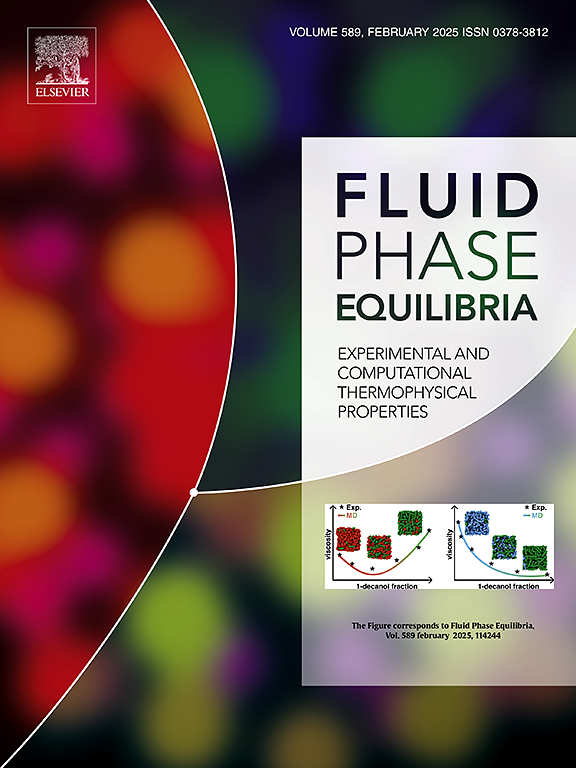用萜类溶剂从水中分离2,3-丁二醇:相平衡和工艺评价
IF 2.7
3区 工程技术
Q3 CHEMISTRY, PHYSICAL
引用次数: 0
摘要
2,3-丁二醇(2,3- bdo)是一种多功能平台化学品,可以通过在水溶液中发酵生产。通过蒸馏从水中回收高沸点2,3- bdo的能源密集型阻碍了生物技术生产2,3- bdo的经济可行性。因此,从萜类化合物,即薄荷醇、百里香酚和香芹酚中,提出了使用新型溶剂的提取-蒸馏工艺。为此,测量了H2O、2,3- bdo和每种萜类化合物的二元和三元液液平衡(LLE)数据,以及2,3- bdo和每种萜类化合物的沸点数据。热力学相平衡与非随机两液(NRTL)模型相关联,并利用Aspen Plus对萃取-精馏过程进行连续工艺设计。传统溶剂(异丁醇、1-丁醇和油醇)、百里香酚和香芹酚根据生产2,3- bdo的特定能源需求进行评估。油醇(5.38 kJ g−1)、百里香酚(5.14 kJ g−1)、香芹酚(5.49 kJ g−1)的比能需要量最低。因此,萜类化合物是一类具有竞争力的溶剂,应纳入溶剂筛选方法。本文章由计算机程序翻译,如有差异,请以英文原文为准。
Terpenoids as solvents for the separation of 2,3-butanediol from water: Phase equilibria and process evaluation
2,3-butanediol (2,3-BDO) is a versatile platform chemical that can be produced via fermentation in aqueous solution. The energy intensive recovery of the high boiling 2,3-BDO from water via distillation hinders the economic viability of biotechnological produced 2,3-BDO. Hence, extraction-distillation processes using novel solvents from the class of terpenoids, namely menthol, thymol, and carvacrol, are proposed. To this end, binary and ternary liquid-liquid equilibrium (LLE) data for H2O, 2,3-BDO, and each terpenoid, as well as boiling point data for 2,3-BDO and the respective terpenoid, are measured. The thermodynamic phase equilibria are correlated with the non-random two liquid (NRTL) model and consecutive process design of the extraction-distillation processes is conducted using Aspen Plus. Conventional solvents (isobutanol, 1-butanol, and oleylalcohol), thymol, and carvacrol are assessed in terms of specific exergy demand for the production of 2,3-BDO. The lowest specific exergy demands were found for oleyl alcohol (5.38 kJ g−1) and thymol (5.14 kJ g−1), carvacrol (5.49 kJ g−1). Hence, terpenoids are a competitive class of solvents and should be included in solvent screening approaches.
求助全文
通过发布文献求助,成功后即可免费获取论文全文。
去求助
来源期刊

Fluid Phase Equilibria
工程技术-工程:化工
CiteScore
5.30
自引率
15.40%
发文量
223
审稿时长
53 days
期刊介绍:
Fluid Phase Equilibria publishes high-quality papers dealing with experimental, theoretical, and applied research related to equilibrium and transport properties of fluids, solids, and interfaces. Subjects of interest include physical/phase and chemical equilibria; equilibrium and nonequilibrium thermophysical properties; fundamental thermodynamic relations; and stability. The systems central to the journal include pure substances and mixtures of organic and inorganic materials, including polymers, biochemicals, and surfactants with sufficient characterization of composition and purity for the results to be reproduced. Alloys are of interest only when thermodynamic studies are included, purely material studies will not be considered. In all cases, authors are expected to provide physical or chemical interpretations of the results.
Experimental research can include measurements under all conditions of temperature, pressure, and composition, including critical and supercritical. Measurements are to be associated with systems and conditions of fundamental or applied interest, and may not be only a collection of routine data, such as physical property or solubility measurements at limited pressures and temperatures close to ambient, or surfactant studies focussed strictly on micellisation or micelle structure. Papers reporting common data must be accompanied by new physical insights and/or contemporary or new theory or techniques.
 求助内容:
求助内容: 应助结果提醒方式:
应助结果提醒方式:


